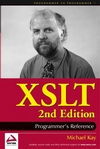|
Home > Learn XML > XML Books > XSLT: Programmers Reference
XSLT: Programmers Reference
XSLT: Programmers Reference covers the following topics:
As an experienced developer, you need to get the facts on a new technology fast. Without the marketing hype, without the trivial introduction. That's what Wrox Programmer's References deliver. Hard facts on the newest technologies with practical examples of how to apply new tools to your development projects today. Table of contents
Author BiographyMichael Kay has spent most of his career as a software designer and systems architect, and has recently moved to Software AG, where he is specializing in XML database and transformation technology. He also represents Software AG on the W3C XSL Working Group. Previously he worked on a number of electronic commerce and publishing projects with ICL, the IT services supplier. His background is in database technology: he has worked on the design of network, relational, and object-oriented database software products as well as a text search engine. In the XML world he is known as the developer of the open source Saxon product. Michael lives in Reading, Berkshire with his wife and daughter. His hobbies, as you might guess from the examples in this book, include genealogy and choral singing. Additional Book Information
|
PURCHASE STYLUS STUDIO ONLINE TODAY!!Purchasing Stylus Studio from our online shop is Easy, Secure and Value Priced! What's New for Stylus Studio® X16?New XQuery & Web Services Tools, Support for MySQL, PostgreSQL, HL7 EDI, Microsoft .NET Code Generation and much more! Why Pay More for XML Tools?With Stylus Studio® X16 XML Enterprise Suite, you get the most comprehensive XML tool suite at one incredibly low price. Value: it's just one of many reasons why smart XML developers are choosing Stylus Studio! |
XML PRODUCTIVITY THROUGH INNOVATION ™

 Cart
Cart



